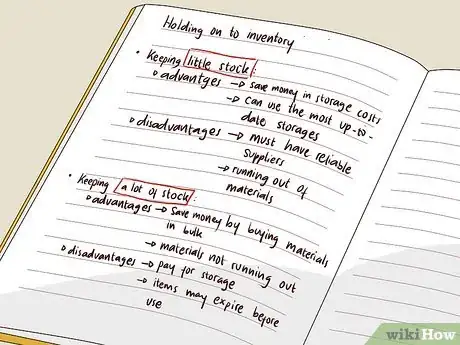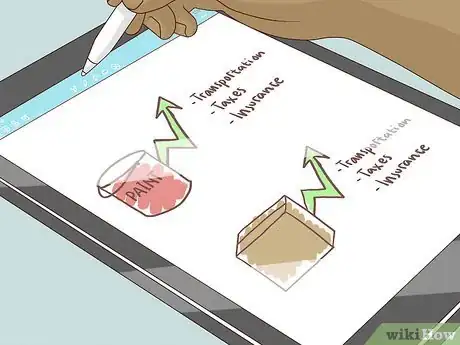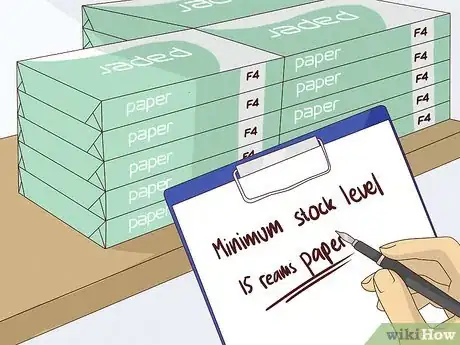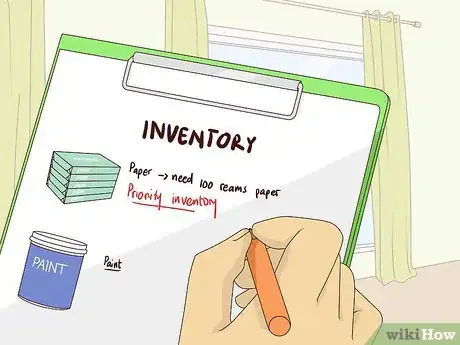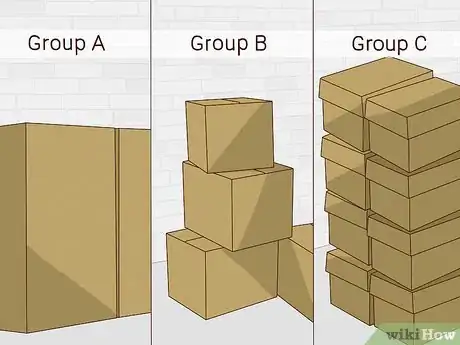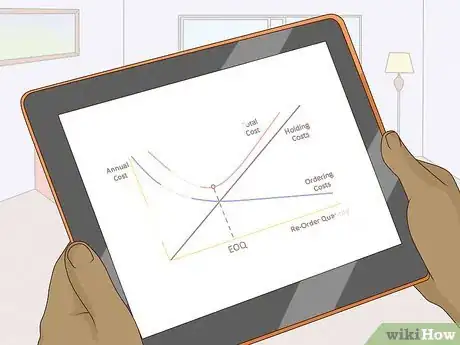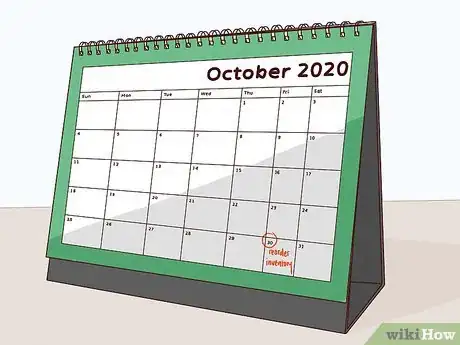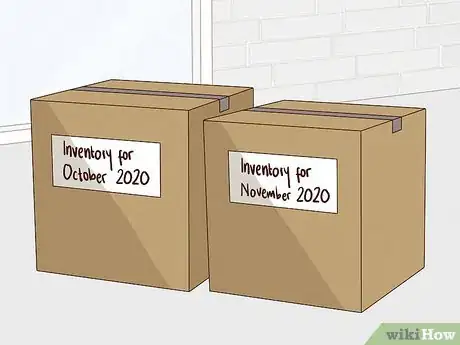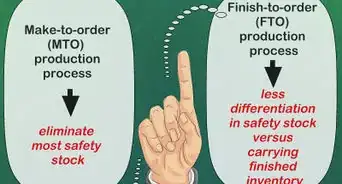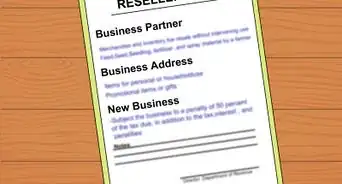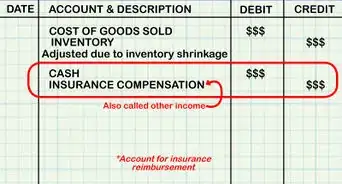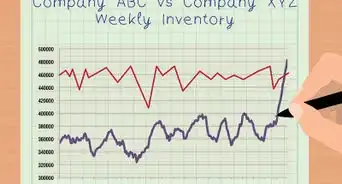This article was co-authored by Keila Hill-Trawick, CPA. Keila Hill-Trawick is a Certified Public Accountant (CPA) and owner at Little Fish Accounting, a CPA firm for small businesses in Washington, District of Columbia. With over 15 years of experience in accounting, Keila specializes in advising freelancers, solopreneurs, and small businesses in reaching their financial goals through tax preparation, financial accounting, bookkeeping, small business tax, financial advisory, and personal tax planning services. Keila spent over a decade in the government and private sector before founding Little Fish Accounting. She holds a BS in Accounting from Georgia State University - J. Mack Robinson College of Business and an MBA from Mercer University - Stetson School of Business and Economics.
There are 7 references cited in this article, which can be found at the bottom of the page.
wikiHow marks an article as reader-approved once it receives enough positive feedback. In this case, 100% of readers who voted found the article helpful, earning it our reader-approved status.
This article has been viewed 136,240 times.
Managing inventory is an important task in many businesses. Inventory comprises the total amount of finished goods and materials on hand and the process of counting them. Many companies do periodic inventory checks to ensure that they will not run out of popular items, while others match the total amount of goods ordered with the physical count. If this process results in an overage or shortage, it will alert you to a problem, such as incorrect inventory tracking or possible theft.
Steps
Setting Up Stock Levels
-
1Know the four categories of inventory. Your inventory consists of everything you use to run your business and to provide your service or produce your products. Inventory can be broken down into four categories. The type of inventory determines how much of it you should keep on hand.[1]
- Raw materials and components are items that you use to produce products.
- Work in progress is your stock of goods that are in the midst of production. They are unfinished.
- Finished goods are your finished products that are ready to be sold.
- Consumables are materials you use to run your business, such as office supplies or fuel.
-
2Understand the advantages and disadvantages of holding on to inventory. You can choose to keep small amounts of stock on hand and have it delivered as you need it. Alternatively, you can choose to keep a lot of stock on hand and store what you are not using currently.[2] Each method has advantages and disadvantages.[3]
- Keeping little or no stock on hand saves you money in storage costs and allows you to always use the most up-to-date components. However, you must have reliable suppliers, and you also run the risk of running out of materials in the midst of production. This also means your costs are related to the latest prices, since every purchase reflects the current price and the purchased inventory is quickly used up.
- Keeping a lot of stock on hand means you may be able to save money by buying materials in bulk, and you never have to worry about running out of materials. However, you may have to pay for storage, and items may expire or become outdated before you can use them. You also assume a price risk if purchases go down in price versus the price of your inventory (but make gain if prices rise).
Advertisement -
3Understand the costs of holding inventory. Determining the optimum stock level involves balancing the different costs associated with storing and purchasing stock. The costs of inventory involve purchasing costs, carrying costs and stock out costs.[4]
- Ordering costs include paying for transportation, paying for staff to receive, store and control quality of materials and paying clerical staff to prepare requisitions, place orders and manage the ordering process.
- Carrying costs include the cost of storage in outside facilities, insurance, taxes, capital costs and the cost of staff to handle the materials.
- Stock out costs refer to the interruption in production if you run out of materials.
-
4Learn how the type of stock influences how much you need to store. The levels of stock you keep may vary depending on the type of stock.[5] For each category, consider the reliability of your suppliers. The price is also a consideration. The price of some materials fluctuates, and you may get discounts for buying certain materials in bulk.[6]
- With raw materials, the schedule and reliability of your suppliers drives how much you keep on hand. It's a good idea to have alternative sources of materials in case of a problem with your supplier. Also, if the price of materials fluctuates you may have to time purchases to take advantage of the best prices.
- Keeping a stock of works in progress can come in handy if there is a problem with delivery of raw materials that interrupts production.
- Only keep a supply of finished products on hand if you are producing items in batches or you are in the midst of producing a large order.
- The level of stock for consumable supplies depends on how you use them, discounts for purchasing in bulk and the reliability of your suppliers.
- You will also need to know how to properly store your products. For example, some products may need to be stored at a specific temperature, or stored in a way that is easy for employees to pick, pack, and ship them easily.
-
5Set a minimum level. This is the level below which stock on hand should never fall. Lead time affects this level. This means how much time it takes to replace stock you have used. Also, the rate of consumption determines the minimum level. Know how quickly you use materials and how much you will use during lead time.[7]
- Lead time is the amount of time you need to replenish the inventory. It is the number of days between when you place an order and when you receive it.
- The rate of consumption is refers to how much of an item you use in a specified time frame.
- Suppose, for example, that you run an office and you need to determine the minimum number of reams of printing paper to keep on hand.
- You know that your supplier can get an order of paper to you within five business days. This is your lead time.
- Also, you know that the office uses an average of three reams of paper per day. This is your consumption rate.
- Since you know your lead time is five days, you must never allow your inventory of paper to fall below five days' worth of paper. If your office uses three reams of paper per day, then a five-day supply would be 15 reams of paper.
- Your minimum stock level is 15 reams of paper.
-
6Determine a re-ordering level. This is the level at which it is time to re-order stock. It is typically somewhere between the maximum and minimum levels. When stock reaches this level, a staff member needs to initiate a purchase requisition. This will start the process of restocking inventory with fresh materials.[8]
- Using the above example, it might not be the best practice to always let your supply of paper dwindle to the minimum level before initiating a replacement order. Any number of circumstances could delay the delivery, and you would be left without any paper in the office.
- To determine a reordering level, you would consider the reliability of your supplier. For example, suppose you know that on a few occasions during the winter months, bad weather delayed your delivery for a few days.
- Based on your history with this supplier, you decide to reorder when your inventory of paper falls to 10 days' worth of paper, or 30 reams.
- The reordering level for paper would be 30 reams.
-
7Set a maximum level. This is the quantity of materials above which you should not keep stock. Setting this level is influenced by many factors. For example, you need to consider the amount of space you have available and the cost of storage. In addition, depending on the type of stock you have, government requirements may limit the amount you can store. However, make sure to consider the chances that you will exceed the maximum level and have a plan in place to liquidate the excess inventory, such as by donating, selling at a discount, or throwing it away. Also, seasonal needs may impact how much you need to have on hand. Finally, depending on your industry, changes in fashion or demand may influence your maximum level of certain materials.[9]
- Some businesses use a the reordering level in a formula to calculate maximum stock levels. This formula is: Maximum Level = Re-ordering Level - Consumption Rate * Lead Time + Economic Order Quantity.
- Economic order quantity (EOQ) is a calculation used to determine a fixed amount when re-ordering inventory. It is discussed later in this article. For this example, assume the EOQ is 30 reams of paper.
- Using the above information, the maximum stock level could be calculated with the formula .
- The maximum level for paper would be 945 reams.
Controlling Inventory
-
1Understand the purpose of controlling inventory. Inventory control comprises the methods you use to maintain your optimum level of stock. You can use whatever combination of methods that makes sense for your business. The first step in inventory control is prioritizing inventory to determine the most important items to manage.[10]
-
2Prioritize inventory using the ABC method. This is a method of controlling stock levels by categorizing inventory into three categories. It is also known as “stock control according to value,” “selective value approach” or “proportional parts value approach.” The purpose is to set priorities for attention to management of these materials. Using this method helps companies to reduce storage expenses and to preserve expensive materials.[11]
- Group A consists of expensive items. These items typically represent 10 to 20 percent of total inventory but 50 percent of the value of inventory. You would invest the bulk of your efforts in controlling these items.
- Group B represents 20 to 30 percent of total inventory and approximately 30 percent of the value of your inventory. These items require moderate inventory control measures.
- Group C represents 70 to 80 percent of total inventory but only about 20 percent of the value. Routine procedures can be used to control this category.
-
3Maintain inventory with a continuous system. A continuous system means that you are ordering a fixed amount each time you order. You order this fixed amount each time inventory reaches a predetermined level. You would use this method with the items you categorized in your “A” category. These are the expensive items that you want to track carefully. You don't want to spend a lot of money in carrying costs, but you don't want to run out of them, so you continuously monitor how much you have.[12]
-
4Calculate the Economic Order Quantity (EOQ) to set the fixed quantity order amount. This mathematical formula is used to determine the optimum level of stock. It is a continuous method of inventory control. You use it to determine the fixed quantity you should order each time you place an order for these items in your inventory. You would use it with your “A” category of inventory items.[13] [14] [15]
- The formula for EOQ is .
- In the formula, Q = the quantity per order, A = the annual amount needed of the item, S = the cost per order and I = the inventory carrying cost per unit per year in dollars.
- For example, suppose you sold basketballs. The cost per order is $400, the carrying cost is $10 per unit per year and you have a demand of 20,000 basketballs per year.
- The optimum average order should be 1,265 basketballs. If the annual demand is 20,000, then you will have to place 16 orders in a year ().
-
5Maintain inventory levels with a periodic system. This means you reorder items after a fixed time period. An order is placed for a variable amount after a fixed amount of time has passed. For example, once per month you place an order for an item, and the amount varies depending on how much the item was used in the previous month. This method works well for the items in your “B” and “C” categories. You don't have to keep control so strictly how much you have on hand, and you can accept the risk of over-ordering by ordering in bulk.[16]
Keeping Track of Your Stock
-
1Perform regular stocktaking. As part of your accounting process, you need to perform an annual stocktaking exercise to determine the value of your inventory. This means making a list, or inventory, of your stock, noting its location and recording its value. Tools such as barcodes or radiofrequency identification (RFID) tags help you to keep track of your stock. You can keep track manually by having staff physically count the stock or electronically with stock control software.[17]
-
2Make sure to include cycle counting. This is an important part of inventory management, so you will need to develop a schedule for cycle counting. Many inventory management software systems make it easy to cycle count by category or subcategory, so make sure to prepare what you plan to count each time. Each time you perform a cycle count, you will need to:
- Close out any open inventory transactions.
- Restock all of your overstock, understock, or backstock.
- Account for all of the received purchase orders and inbound transfers in your system.
- Put away all items.
- Close and invoice all completed customer orders.
-
3Use a manual method. Manual systems work best for small businesses with few stock items. You can choose from two methods for manual inventory control. The first is known as the two bin inventory control system. The second system involves creating a descriptive index and using inventory control cards.
- For the two bin system, determine a buying cycle for items and the amount purchased in each cycle. For example, offices may purchase office supplies weekly or monthly. To begin, purchase enough of the item to last two buying cycles. Divide the items into two bundles. When the first bundle is used up, it's time to reorder enough for one buying cycle of the item. Materials from the second bundle are used while the materials are being reordered.
- For the second system, create an index that lists all of the items in inventory and a file of cards for each item. On each card, record an item description. When an item is purchased or reordered, someone records the amount received, the unit price and other information such as an ordering description, a catalog number or the serial number.
-
4Use computer software. Inventory management software tracks inventory levels and records purchases, deliveries and sales of items in inventory. Factories can also use it to produce production-related documents such as work orders and bills or materials. It can perform an EOQ analysis of your inventory to help you keep optimum levels of inventory on hand.[18]
- The advantages of using inventory management software include decreased carrying cost and ordering costs, increased efficiency of inventory management, better organization and security and information about trends in how materials are used.
- The disadvantages are that the software can be expensive, and it can be complex to use.
Expert Q&A
-
QuestionWhat is inventory turnover?
 Keila Hill-Trawick, CPAKeila Hill-Trawick is a Certified Public Accountant (CPA) and owner at Little Fish Accounting, a CPA firm for small businesses in Washington, District of Columbia. With over 15 years of experience in accounting, Keila specializes in advising freelancers, solopreneurs, and small businesses in reaching their financial goals through tax preparation, financial accounting, bookkeeping, small business tax, financial advisory, and personal tax planning services. Keila spent over a decade in the government and private sector before founding Little Fish Accounting. She holds a BS in Accounting from Georgia State University - J. Mack Robinson College of Business and an MBA from Mercer University - Stetson School of Business and Economics.
Keila Hill-Trawick, CPAKeila Hill-Trawick is a Certified Public Accountant (CPA) and owner at Little Fish Accounting, a CPA firm for small businesses in Washington, District of Columbia. With over 15 years of experience in accounting, Keila specializes in advising freelancers, solopreneurs, and small businesses in reaching their financial goals through tax preparation, financial accounting, bookkeeping, small business tax, financial advisory, and personal tax planning services. Keila spent over a decade in the government and private sector before founding Little Fish Accounting. She holds a BS in Accounting from Georgia State University - J. Mack Robinson College of Business and an MBA from Mercer University - Stetson School of Business and Economics.
Certified Public Accountant Inventory turnover basically refers to how long it takes for the inventory you buy to end up going out the door. It's useful to track since it can tell you whether you're over- or under-spending on stock, and it can give you insight into whether you're being efficient or not from a supply perspective.
Inventory turnover basically refers to how long it takes for the inventory you buy to end up going out the door. It's useful to track since it can tell you whether you're over- or under-spending on stock, and it can give you insight into whether you're being efficient or not from a supply perspective. -
QuestionIs it bad to hold on to inventory for too long?
 Keila Hill-Trawick, CPAKeila Hill-Trawick is a Certified Public Accountant (CPA) and owner at Little Fish Accounting, a CPA firm for small businesses in Washington, District of Columbia. With over 15 years of experience in accounting, Keila specializes in advising freelancers, solopreneurs, and small businesses in reaching their financial goals through tax preparation, financial accounting, bookkeeping, small business tax, financial advisory, and personal tax planning services. Keila spent over a decade in the government and private sector before founding Little Fish Accounting. She holds a BS in Accounting from Georgia State University - J. Mack Robinson College of Business and an MBA from Mercer University - Stetson School of Business and Economics.
Keila Hill-Trawick, CPAKeila Hill-Trawick is a Certified Public Accountant (CPA) and owner at Little Fish Accounting, a CPA firm for small businesses in Washington, District of Columbia. With over 15 years of experience in accounting, Keila specializes in advising freelancers, solopreneurs, and small businesses in reaching their financial goals through tax preparation, financial accounting, bookkeeping, small business tax, financial advisory, and personal tax planning services. Keila spent over a decade in the government and private sector before founding Little Fish Accounting. She holds a BS in Accounting from Georgia State University - J. Mack Robinson College of Business and an MBA from Mercer University - Stetson School of Business and Economics.
Certified Public Accountant It totally depends on the shelf life. If you're holding on to goods that are going to expire at some point in the future, then yes, you want to unload as much inventory as you possibly can. If you have the storage space and your inventory isn't going to lose its value though, it's perfectly fine to hold on to it.
It totally depends on the shelf life. If you're holding on to goods that are going to expire at some point in the future, then yes, you want to unload as much inventory as you possibly can. If you have the storage space and your inventory isn't going to lose its value though, it's perfectly fine to hold on to it. -
QuestionWhat are some methods of keeping inventory?
 Jill Newman, CPAJill Newman is a Certified Public Accountant (CPA) in Ohio with over 20 years of accounting experience. She has experience working as an accountant in public accounting firms, nonprofits, and educational institutions, and has also honed her communication skills via an MA in English, writing jobs, and as a teacher. She received her CPA from the Accountancy Board of Ohio in 1994 and has a BS in Business Administration/Accounting.
Jill Newman, CPAJill Newman is a Certified Public Accountant (CPA) in Ohio with over 20 years of accounting experience. She has experience working as an accountant in public accounting firms, nonprofits, and educational institutions, and has also honed her communication skills via an MA in English, writing jobs, and as a teacher. She received her CPA from the Accountancy Board of Ohio in 1994 and has a BS in Business Administration/Accounting.
Financial Advisor The methods of inventory keeping include minimum stock level, just in time, economic order quantity and safety stock. All methods aim toward one target--to have the lowest total cost of ownership while having the highest possible service levels.
The methods of inventory keeping include minimum stock level, just in time, economic order quantity and safety stock. All methods aim toward one target--to have the lowest total cost of ownership while having the highest possible service levels.
References
- ↑ http://www.infoentrepreneurs.org/en/guides/stock-control-and-inventory/#8
- ↑ Keila Hill-Trawick, CPA. Small Business Advisor. Expert Interview. 30 July 2020.
- ↑ http://www.infoentrepreneurs.org/en/guides/stock-control-and-inventory/#8
- ↑ Keila Hill-Trawick, CPA. Small Business Advisor. Expert Interview. 30 July 2020.
- ↑ Keila Hill-Trawick, CPA. Small Business Advisor. Expert Interview. 30 July 2020.
- ↑ http://www.infoentrepreneurs.org/en/guides/stock-control-and-inventory/#8
- ↑ http://www.slideshare.net/ashfaqumarr/retail-inventory-management-control
- ↑ http://www.slideshare.net/ashfaqumarr/retail-inventory-management-control
- ↑ http://www.slideshare.net/ashfaqumarr/retail-inventory-management-control
- ↑ Keila Hill-Trawick, CPA. Small Business Advisor. Expert Interview. 30 July 2020.
- ↑ http://www.yourarticlelibrary.com/inventory-control/6-most-important-techniques-of-inventory-control-system/26159/
- ↑ http://www.slideshare.net/ashfaqumarr/retail-inventory-management-control
- ↑ http://www.infoentrepreneurs.org/en/guides/stock-control-and-inventory/#8
- ↑ http://www.yourarticlelibrary.com/inventory-control/6-most-important-techniques-of-inventory-control-system/26159/
- ↑ https://xplaind.com/333007/economic-order-quantity
- ↑ http://www.slideshare.net/ashfaqumarr/retail-inventory-management-control
- ↑ http://www.infoentrepreneurs.org/en/guides/stock-control-and-inventory/#8
- ↑ http://www.waspbarcode.com/buzz/what-is-inventory-management-software/
About This Article
If you want to keep inventory, first you'll need to determine the minimum level of stock you need to keep on hand at all times. To find the minimum level of stock, multiply your consumption rate, or how much of the stock you use each day, by the lead time, which is how long it takes you to order and receive new inventory. For example, if your business uses 3 reams of paper a day, and it takes 5 days to receive new paper, you'd need to have at least 15 reams of paper in stock at all times. You should also take into consideration how much space you have and how much stock you can realistically use so you can set a maximum stock level, which will help prevent you from wasting supplies. Then, to maintain your inventory, plan on ordering a fixed amount of stock every time your current inventory drops to a predetermined level. Alternatively, you can just order new inventory after a fixed period of time, like once every month. For more tips from our Financial co-author, like how to keep track of your inventory, scroll down!

